

The former favors the multivalent and cooperative binding of origami units into hierarchical structures, (37,40) the latter provides a unique mechanism of self-association that solely relies on the geometry of the building block. More efforts in this direction are motivated by at least two features of origami structures that are absent in DNA tiles, namely, (i) a high number of interactions per monomeric unit and (ii) shape-complementarity rules of interunit recognition. (31−41) Only few recent studies have focused on the programmable valency of DNA origami patchy particles as a means to control the degree of monomer hybridization into polymers, (37−43) whereas, to the best of our knowledge, no reports have yet addressed the different impact of base-stacking and base-hybridization on the temporal evolution of these structures. (28−30) Conversely, the use of DNA origami structures as building elements of synthetic filaments has been so far mainly limited to the structural characterization of the end products. (25−28) Recent findings have shown that large DNA architectures, such as DNA origami, can be advantageously employed as nucleation seeds for the assisted growth of DNA-tile assemblies.

(17) These small intertwined motifs are equipped with short single-stranded extensions, whose programmable hybridization dictates the association rate and strength of tile-to-tile binding (18−24) and obeys a nucleation-and-growth mechanism. Our work thus provides insights into the thermodynamics and kinetics of hierarchical DNA origami assembly and shows how it can be mastered by the anisotropy of the building unit and its self-association mode.Ī successful approach for the realization of synthetic filaments relies on the use of DNA tiles. By observing the temporal evolution of the system toward equilibrium, we reveal kinetic aspects of filament growth that cannot be easily captured by postassembly studies. We here explore the thermodynamic and kinetic properties of linear structures grown from a ditopic DNA origami unit, i.e., a monomer with two distinct interfaces, and employ either base-hybridization or base-stacking interactions to trigger the dimerization and polymerization process. Among them, DNA origami filamentous structures are of particular interest, due to the versatility of morphologies, mechanical properties, and functionalities attainable. Synthetic DNA filaments exploit the programmability of the individual units and their predictable self-association to mimic the structural and dynamic features of natural protein filaments.


 0 kommentar(er)
0 kommentar(er)
